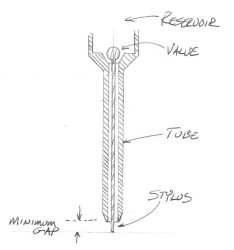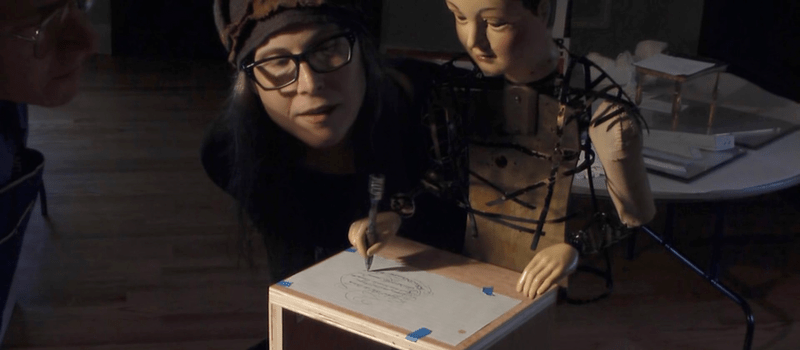We’re not specialists, but the Maillardet Automaton is one of the more amazing mechanical machines that we’ve seen in a while, and [Fran Blanche] got to spend some time with it in an attempt to figure out how it’s mysterious missing pen apparatus would have worked. The resulting video, embedded below, is partially her narrative about the experiment she’s running, and part straight-up mechanical marvel.
If you need a refresher course on Maillardet’s Automaton, we’ll send you first to Wikipedia, and then off to watch this other video , which has a few great close-ups of the cams that drive everything.
 And then come back to [Fran]’s video. Many parts of the machine, including the pen and his clothes, are missing. Because the machine’s hand moves in three dimensions, pressing down on the pen harder in the downstroke than on the upstroke, the pen’s construction is important for a faithful reproduction of the machine’s full abilities. [Fran] builds a weighted ball-point pen design to test out her theory that the missing pen was essentially a spring valve that feeds more ink when pressed down further.
And then come back to [Fran]’s video. Many parts of the machine, including the pen and his clothes, are missing. Because the machine’s hand moves in three dimensions, pressing down on the pen harder in the downstroke than on the upstroke, the pen’s construction is important for a faithful reproduction of the machine’s full abilities. [Fran] builds a weighted ball-point pen design to test out her theory that the missing pen was essentially a spring valve that feeds more ink when pressed down further.
Besides hearing [Fran] work through the experiment, you also get to watch this enchanting machine do its thing for ten minutes, and that alone is worth your time. If you want more Maillardet Automaton goodness, check out our previous coverage of [Fran]’s work on the machine or her blog coverage thereof. Or lighten up a bit with this whimsical “robot” café.















Fran’s suggestion of a valve operated by a pin in the stylus is available today in Rotring and Staedtler technical pens. She could’ve just used one of those instead of trying to hack a gel pen to do the trick.
Love her work, though.
the rotring pens are kind of delicate and the flow is not variable.. either you have the intended line width or you have nothing. that you need here is a pen that works like a quill giving a variable line width to get a calligraphic effect.
I understand, but what she has drawn is the exact same mechanism. And they’re not at all delicate – the finest ones may be, but they come in many tip sizes. Also, the automaton isn’t pressing down very hard.
I’d suggest that the pen motion matches that of a quill pen. Push down to get a wider stroke, release for a thinner stroke.
And couldn’t the counterweight spring problem be fixed by angling the desk slightly?
Fran gets to do the coolest stuff! I watched this when she first put it up, and then watched and read most of the other info about this amazing machine. Fascinating.
She does address the issue of using a drafting pen. The purpose of this test was to see what effect the height variations of the hand had on the writing. Using and off the shelf drafting pen would not have done the job. If you watch the pen closely you can see that her “hack” has allows a big variation in height, while also showing the variations. From reading some of what she has written about this project she intends to make a more permanent device to go in the machine when the restoration is finished and it can go back on public display. I think I would probably make a trip to the US just to see this machine in action. Sadly I don’t think I could afford that so thank you Fran & HAD for letting me watch by proxy.
If Switzerland’s any closer, there’s the Jacquet-Droz automata. Those are even better than this one, and fully working.
The images of the current drawings by the machine have the pen never leaving the paper. The one old image on the Wikipedia article shows it lifted the pen off the paper.
The linked video is not available for viewing worldwide.
Thanks for posting this Elliot!
A few technical specifics for the commenters:
1) The automaton is from the late 1790’s and the first steel flex nibs were produced about 40 years or so after this machine was completed.
2) The pen is perpendicular to the paper at all times, and writes in all directions without rotating. If you have spent any time writing with a quill as I have, you’ll know they just don’t write like that.
3) The original variation in line width is dramatic, perhaps more than 1:10, as can be seen in this very early rendering – http://douglasstewart.com.au/objects/a-sample-poem-written-by-maillardets-draughtsman-writer-automaton-circa-182/
4) The thinnest lines are extremely fine, and both the thinnest and widest lines are all drawn vertically, horizontally, and diagonally, without any change in the pen’s orientation, which makes the design of the tip quite magnificent.
5) The metals that make modern fountain pens possible did not yet exist in 1790, and the automaton had to write continuously for hours without apparent human intervention – that was the great illusion it gave to spectators.
More work and study to do – and thanks to everyone for watching!
I think the pen concept you have isn’t the right one for controlling line width. Ink flow is controlled by surface tension and capillary action. I’ve used all these pen types, including bird feather quills and my observation leads me to believe that ink won’t flow from the tip of the center rod; if it did the reservoir would rapidly drain as there isn’t anything that resists the flow.
Superior alloys were available, just not in large or cheap quantities, so I would not rule that out. This was not built by a casual fabricator.
It is possible the original had a wire in a tube, but to prevent clogging of the pen nozzle and to guide the surface tension out of the tube, which is the reason they are used in technical pens. Split nib pens mechanically break loose any dried material with the deflection of the split.
It looks more like the action a fine brush would produce, which may be why it isn’t there any longer.
All the best – it is a remarkable machine and deserving of caring curators.
The drawing I made several years ago, and it was a first impression – Since doing the test with the Automaton I have refined the idea and teh tube would likely be quite short with the valve close to the opening. I will update the blog after I have been able to test it in a real world experiment. The early renderings would suggest that the ink was made fast, perhaps by adding some alcohol, as the ink seems not to have stood up on the paper or bled.
In college, I had the privilege of working part-time at the Franklin Institute and was one of only a few people trained to use the Automaton. There’s quite a bit of history and legend behind it, including that it’s cursed. Allegedly everyone that worked to restore it died! Also, since it’s original clothes were lost in the fire, the dolls gender was not known, and girl’s clothes were made for it. Careful analysis of the French poems it writes implies that the doll is in fact a boy! Maybe that’s why he cursed every one.
The saddest part of the story is that the machine (at least when I was there some years ago), mostly sits idle. When it does get demoed, most kids aren’t particularly interested, and most adults don’t really appreciate the technological, historical, and craftsmanship significance this beautiful automaton.
Things made with real, physical moving parts are WAY more interesting and challenging than code…
The legends surrounding the Automaton are largely untrue. There is no evidence that it was ever in a fire, or owned by Barnum – but it did arrive at the Franklin in a disassembled and incomplete state. It was presented as “The Philadelphia Doll” in the 60’s-70’s as a female in a period dress, but several depictions of the early machine in drawings show it wearing either a sailor’s uniform and cap, or that of a romantic scribe. Much of its history is simply lost, but we have learned a great deal over the past few years with better research. No one has died working on the machine (or after), as we all can attest to that!
I’m disappointed but not surprised… I had some hands-on training with one of the old-timers there, but I was also handed a stapled-pile of ancient nth generation photocopied mimeographs of background material. This was pre-Google, and it wasn’t very easy to casually research esoteric “tech” history like it is now. Thanks for a great article!
Analog computers are kind of a lost art.
And by an interesting coincidence… My daughter and I were at the Franklin Institute just last weekend (we both rode the sky bike) and we saw this automaton.. She said it looked better in the movie Hugo, I told her CGI helps.
That and the “Hugo” automaton incorporated some movements just for the sake of being flashy, like the Geneva wheels. (Their use in the movie equipment, though, made sense – they probably pulled them out of a movie camera for the automaton rather than the other way around!)
Excellent.
Glad you enjoyed it Bil! :-)